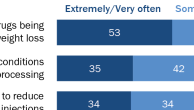About this report
This report is based on the findings of a daily tracking survey on Americans’ use of the Internet. The results in Section One are based largely on data from roughly six months of telephone interviewing conducted by Princeton Survey Research Associates between March 1, 2000 and August 20, 2000, among a sample of 12,751 adults, 18 and older. Some 6,413 of them are Internet users. For results based on the total sample, one can say with 95% confidence that the error attributable to sampling and other random effects is plus or minus 2.5 percentage points. A special survey of 2,109 adults (1,101 are Internet users) was conducted between July 24 and August 20, 2000 and dealt primarily with health privacy issues. Results in Section Two of this report are based largely on data from a special survey of 521 Internet users who go online for health care information. For results based on this second survey, the margin of error is plus or minus 5 percentage points. In addition to sampling error, question wording and practical difficulties in conducting telephone surveys may introduce some error or bias into the findings of opinion polls.
The sample for this survey is a random digit sample of telephone numbers selected from telephone exchanges in the continental United States. The random digit aspect of the sample is used to avoid “listing” bias and provides representation of both listed and unlisted numbers (including not-yet-listed numbers). The design of the sample achieves this representation by random generation of the last two digits of telephone numbers selected on the basis of their area code, telephone exchange, and bank number.
A new sample was released daily and was kept in the field for at least five days. This insures that the complete call procedures are followed for the entire sample. Additionally, the sample was released in replicates to insure that the telephone numbers called are distributed appropriately across regions of the country. At least 10 attempts were made to complete an interview at every household in the sample. The calls were staggered over times of day and days of the week to maximize the chances of making contact with a potential respondent. Interview refusals were re-contacted at least once in order to try again to complete an interview. All interviews completed on any given day were considered to be the final sample for that day.
Non-response in telephone interviews produces some known biases in survey-derived estimates because participation tends to vary for different subgroups of the population, and these subgroups are likely to vary also on questions of substantive interest. In order to compensate for these known biases, the sample data are weighted in analysis. The demographic weighting parameters are derived from a special analysis of the most recently available Census Bureau’s Current Population Survey (March 1999). This analysis produced population parameters for the demographic characteristics of adults age 18 or older, living in households that contain a telephone. These parameters are then compared with the sample characteristics to construct sample weights. The weights are derived using an iterative technique that simultaneously balances the distribution of all weighting parameters.
Throughout this report, the survey results are used to estimate the approximate number of Americans, in millions, who engage in Internet activities. These figures are derived from the Census Bureau’s estimates of the number of adults living in telephone households in the continental United States. As with all survey results, these figures are estimates. Any given figure could be somewhat larger or smaller, given the margin of sampling error associated with the survey results used in deriving these figures.




